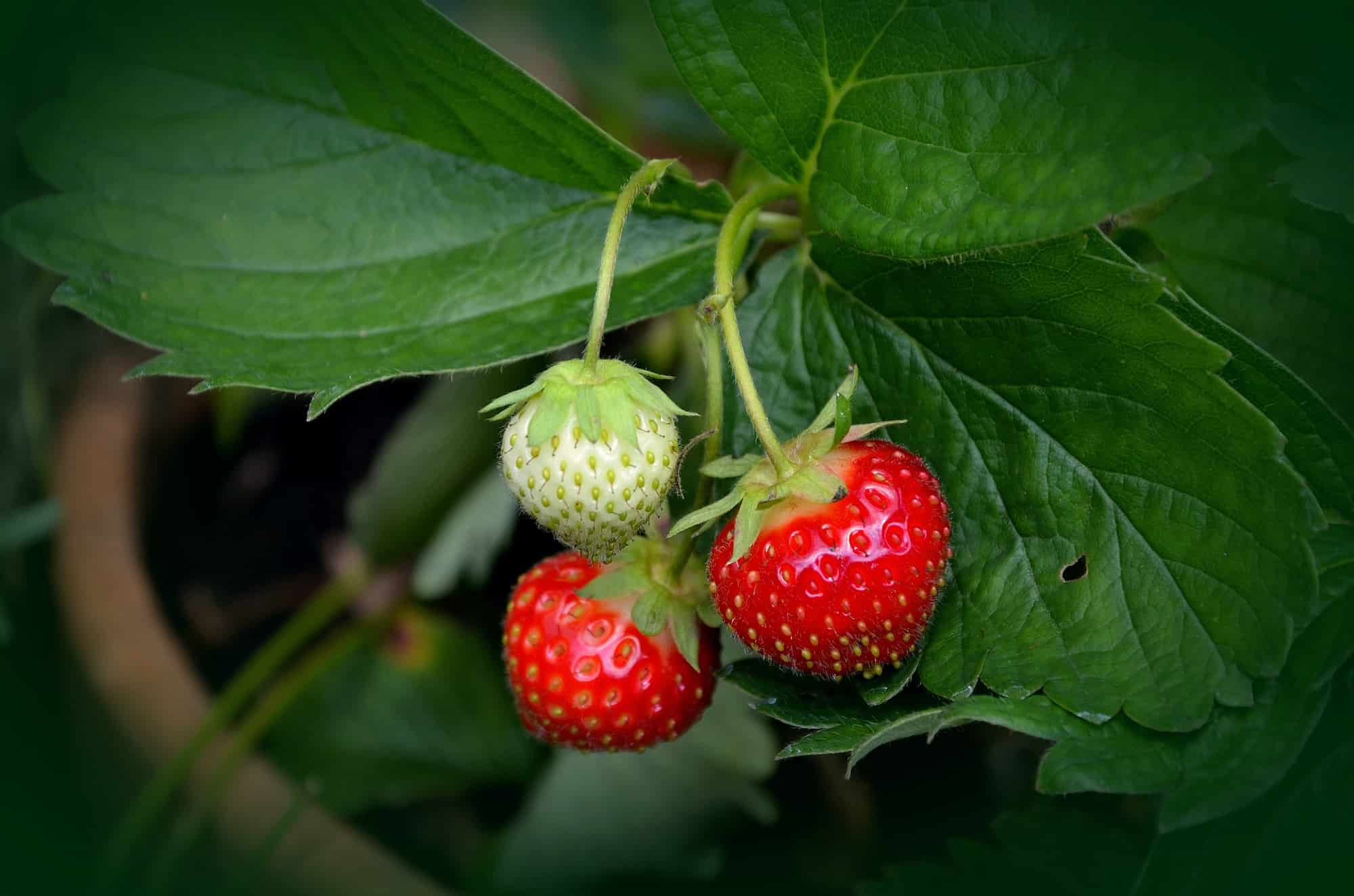
Diseases and pests of strawberries
All our tips to identify, prevent, and naturally treat strawberry diseases and pests
Contents
Queen of the small red fruits, strawberry is widely cultivated in vegetable gardens. Firstly, because the range of varieties, whether repeat flowering or not, is sufficiently vast to satisfy the pleasure of all gourmands. Secondly, because strawberry plants (Fragaria), perennial plants from the Rosaceae family, are relatively easy to grow as long as they are provided with sunlight, which guarantees sweet and fragrant fruits, fertile and humus-bearing soil, preferably loose and well-worked, good mulching, and regular watering. Finally, the hardiness of this creeping plant allows for strawberry harvesting throughout France, both in open ground and in pots on a balcony or terrace. Although easy to care for, the strawberry plant can be subject to a number of attacks mainly due to fungal diseases or, more rarely, a few pests. We will explain in detail how to identify, prevent, and treat strawberry diseases naturally.
Fungal diseases of strawberries
High humidity combined with mild temperatures encourages the emergence of fungi, these microorganisms that are vectors of cryptogamic diseases. Strawberries are not exempt from these diseases, which can have serious consequences on fruit production.
Botrytis or grey mould
Description
The fungus known as Botrytis cinerea is responsible for this disease commonly referred to as grey mould. Botrytis can develop from early spring until autumn under rainy and warm climatic conditions.
Symptoms
A white to greyish fluff and brown spots appear on the flowers and fruits, rendering them unfit for consumption. The fruits rot and then dry out.
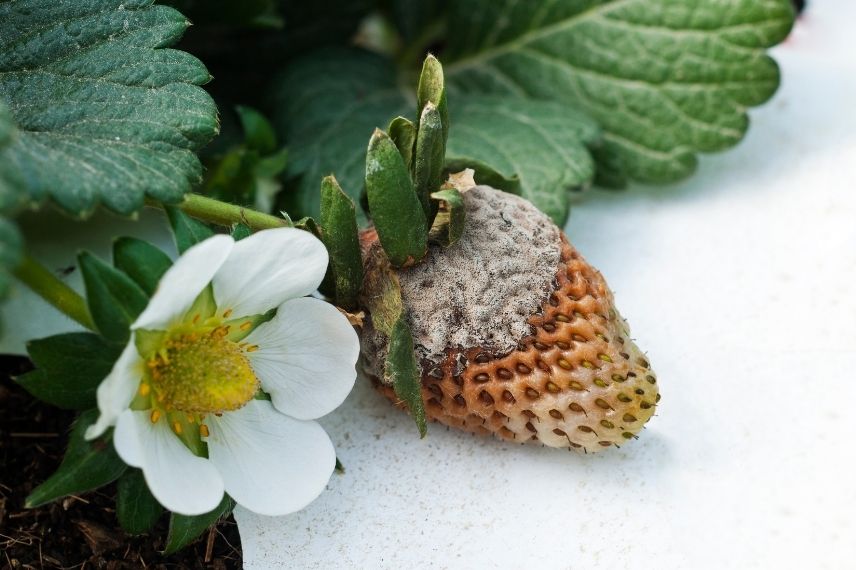
Grey mould or Botrytis on a strawberry
Prevention
- Mulch strawberry plants as soon as they start flowering with garden mulch made from flax or hemp
- Reduce watering
- Weed the strawberry beds thoroughly, as adventive plants can harbour the fungus
- Limit nitrogen fertiliser applications
Natural treatments
- Immediately remove affected fruits and wilted flowers
- Bordeaux mixture can be effective against grey mould
- A spray of horsetail decoction is recommended.
Anthracnose
Description
This cryptogamic disease is caused by the presence of a fungus called Colletotrichum fragariae. Again, it appears in humid and warm weather.
Symptoms
Lesions of about 1 to 2 cm in diameter appear on the fruits. Initially bronze in colour, they turn pink and then brown. They are accompanied by a central depression as if a finger had been pressed into the strawberry.
Prevention
- Limit nitrogen fertiliser applications
- Water without wetting the foliage
- Ensure good air circulation in the plantings
Natural treatments
- Remove affected fruits to prevent spread
- Treat with Bordeaux mixture
Strawberry powdery mildew
Description
It is often the fungus Sphaerotheca macularis that is responsible for strawberry powdery mildew. This disease appears when there are alternating periods of rain and sunshine.
Symptoms
A white fluff develops on all parts of the plant, including flower stalks and fruits. Similarly, the underside of the leaves becomes reddish. They curl and eventually dry out.
Prevention
- Do not plant too closely together
- Avoid fertilisers that are too rich in nitrogen
Natural treatments
- Spray solutions of baking soda
- Apply a horsetail decoction
Phytophthora or strawberry downy mildew
Description
This is mainly observed in spring. Phytophthora is favoured by soil moisture and is caused by Phytophthora fragariae.
Symptoms
It is primarily the leaves that are affected as they turn brown and dry out. The plants become stunted, and fruits do not appear or are few and inedible.
Prevention
- Ensure good air circulation by not planting too closely
- If downy mildew attacks occur, plant strawberries elsewhere the following year
Natural treatments
- Spray a solution of baking soda or Bordeaux mixture
- Remove affected plants to slow the spread of the disease
Purple spot disease
Description
Favoured by humidity, this is a less severe disease that often occurs in autumn. Purple spot disease can be caused by various fungi, the most common being Diplocarpon earlianae, but also Mycosphaerella fragaria, Dendrophoma obscurans, and Septogioeum fragariae.
Symptoms
Round spots of 3 to 5 mm appear on the upper side of the leaves, resembling burns. They are initially purple with a lighter centre, then turn brown-black before spreading. The foliage eventually dries out, and the plant wilts.
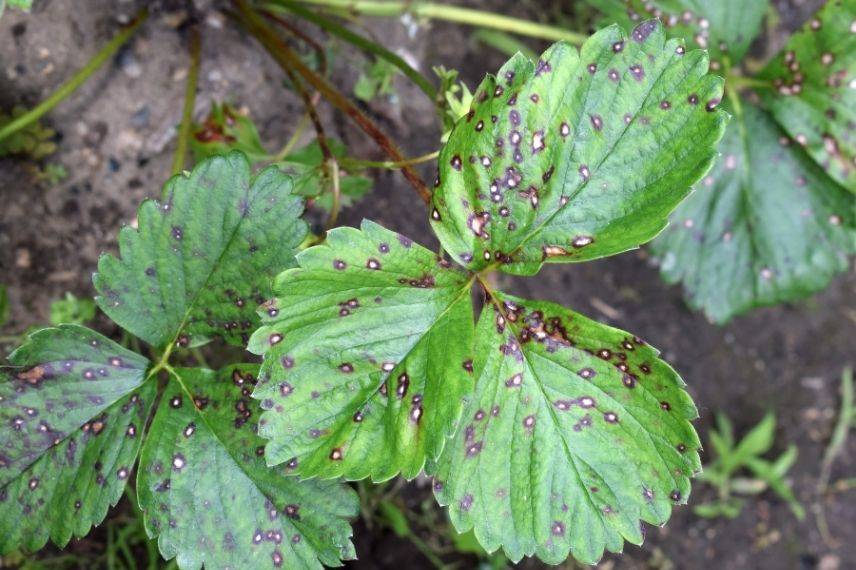
Purple spot disease caused by Mycosphaerella fragaria
Prevention
- Water without wetting the foliage
- Ensure good air circulation by not planting too closely
- Limit nitrogen applications
Natural treatments
- Remove contaminated leaves
- Burn potentially contaminated crop residues
- Regularly spray a horsetail decoction
- In case of severe attack, spray Bordeaux mixture preventively in spring
Phomopsis burn
Description
Similar to anthracnose, this cryptogamic disease is caused by Phomopsis obscura.
Symptoms
Leaves become covered with spots resembling burns. These spots are round, brown, surrounded by a red halo.
Natural treatment
- Spray baking soda
Verticillium wilt
Description
This disease is caused by the fungus Verticillium, which often triggers under cool, humid conditions.
Symptoms
Leaves begin to yellow and then wilt. Subsequently, the strawberries decline.
Prevention
- Hill up strawberries
- Prefer drip irrigation
- Rotate crops for more than 4 years
Natural treatment
- Remove infected plants
Read also
Strawberries: planting, growing and carePests of strawberry plants
Strawberries are also the target of many pests, some more discreet than others.
The Spotted millipede
Description
Also known as the strawberry millipede (Blaniulus guttulatus), it is a white-bodied millipede with pink or red spots on the sides. It feeds on decomposing organic matter.
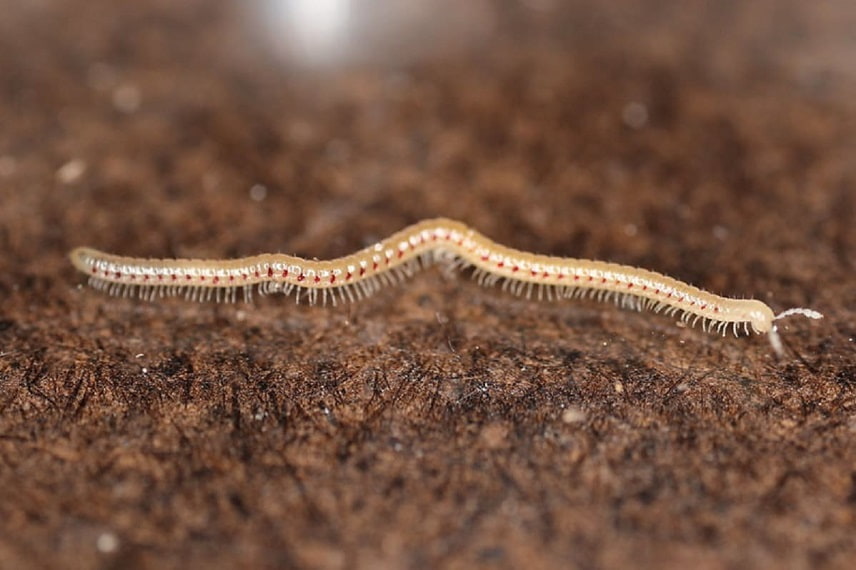 The spotted millipede
The spotted millipede
Symptoms
Strawberries are eaten.
Prevention
As the millipede lays its eggs in the soil, simply mulching is enough to protect against it.
The Strawberry tarsonemid
Description
This is a tiny mite (Tarsonemus pallidus) transmitted by infected plants, oval in shape and amber in colour, which feeds on the leaves of the strawberry plant. The female lays eggs in March at the heart of the plants, and generations persist.
Symptoms
The damage is rarely significant. Leaves become distorted and stunted, crinkled, and brown. Buds and flowers shrivel and dry out.
Prevention
- Pair strawberries with garlic, onion, and leeks
- Water with infusions of garlic or onion skins
Natural treatment
- Regularly spray an infusion of garlic cloves or garlic essential oil
- Renew plantings with healthy plants
Aphids
Description
Like many other plants, strawberries can be infested with aphids. While not particularly harmful in themselves, aphids can weaken plants by extracting sap for nourishment and especially facilitate the introduction of diseases such as sooty mould, leaf curl, or mosaic. On strawberries, green or yellow aphids are most commonly encountered.
Symptoms
Leaves curl in on themselves and floral buds become distorted. A sticky liquid called honeydew settles on the leaves.
Prevention
- Regular sprays of nettle manure or garlic decoction
- Introduce ladybird or lacewing larvae.
Natural treatment
The most effective natural treatment against aphids is diluted black soap in hot water at a rate of tablespoons per litre of water.
The raspberry or strawberry weevil
Description
The raspberry and strawberry weevil (Anthonomus rubi) is a black beetle measuring 2 to 4 mm. In May, the female lays eggs in the floral buds of the strawberry plant. The larva, white and legless, remains for three weeks in this bud or in fallen buds before pupating. The adult overwinters in the soil or under decaying plant material and is only active from 18 °C.
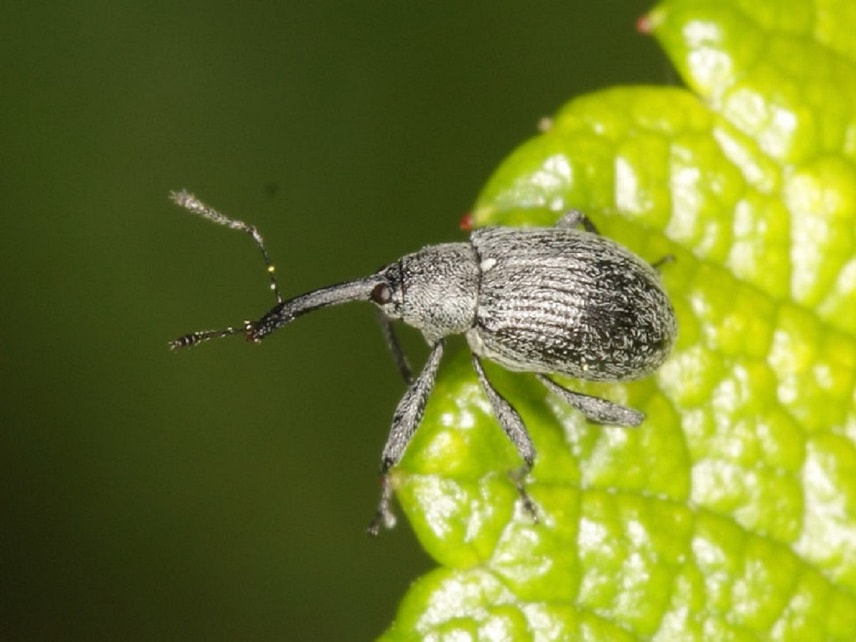 The weevil is found on strawberries and raspberries
The weevil is found on strawberries and raspberries
Symptoms
The flower stalk is bitten, floral buds dry out and detach.
Prevention
- Cover the soil early in spring or after harvest with fern leaves.
- Place straw pads in the strawberry plants and burn them in winter.
Natural treatments
- Collect fallen floral buds and destroy them
- Treat the soil with tansy manure just after harvest.
- Spray garlic or clove essential oil before the strawberries flower.
Otiorhynchus
Description
The otiorhynchus (Otiorrhynchus sulcatus) is a black beetle measuring 10 mm. With an elongated head, the adult emerges from late May. After feeding at night, primarily on leaves, for 4 to 5 weeks, it lays its eggs in the soil. The larvae, yellowish-white grubs with a brown head, then appear and attack the collar and roots of the strawberries.
 The otiorhynchus can cause the death of strawberry plants
The otiorhynchus can cause the death of strawberry plants
The spread of otiorhynchi accelerates under cover, in sheltered situations, or in potted strawberry plantations.
Symptoms
Eaten leaves are deeply notched. Damage can be significant, leading to the death of strawberries.
Prevention
- Cover the soil with a layer of wood shavings compost enriched with compost.
- Work the soil frequently
- When planting strawberries, shake the plant well to dislodge any larvae.
Natural treatments
- Collect adults at night.
- Dig up larvae near the roots
- Water the plants with tansy infusions and spray the leaves.
- Place a nematode trap for otiorhynchi at the base of the plants. These microscopic worms parasitise and kill the adults.
Discover other Strawberry seeds
View all →Available in 1 sizes
Available in 1 sizes
Available in 1 sizes
Available in 1 sizes
Available in 1 sizes
Available in 1 sizes
Available in 1 sizes
Available in 1 sizes
Other pests for strawberries
Other predators such as snails, slugs, and birds delight in strawberry plants and especially in just-ripe strawberries. To combat snails and slugs, a mulch of pine needles or straw is quite effective, as is hand-picking the pests and encouraging them to go elsewhere. To deter the greed of birds, the most radical solution remains the installation of protection nets.
- Subscribe!
- Contents
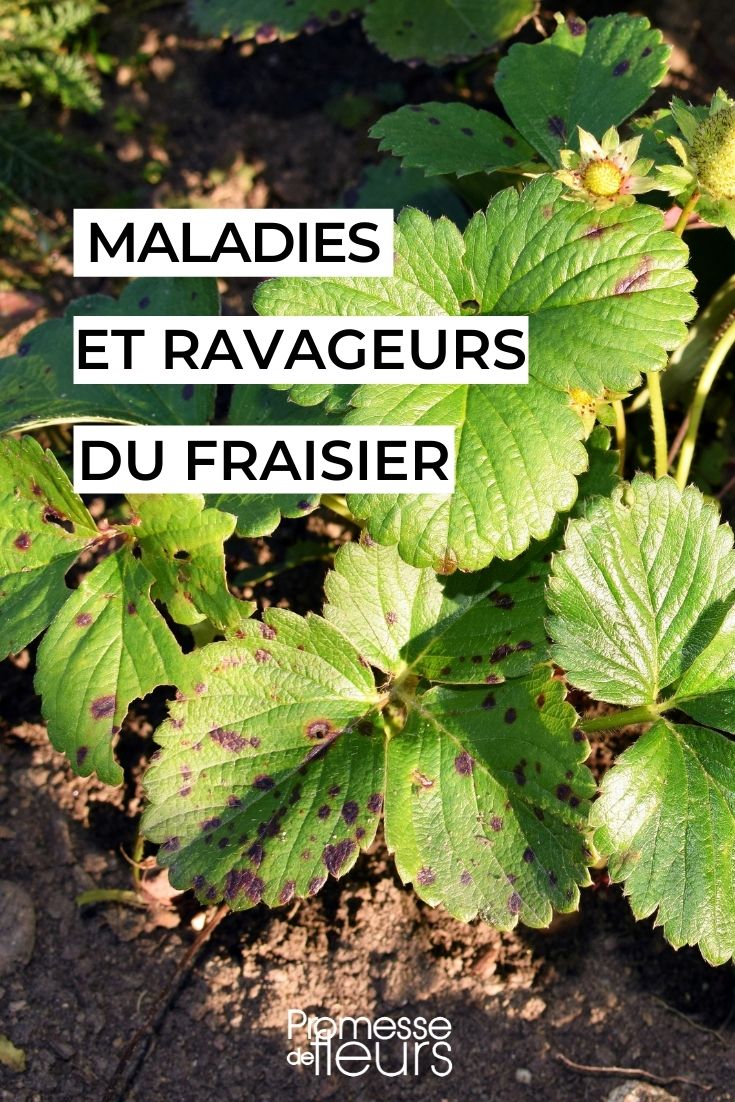































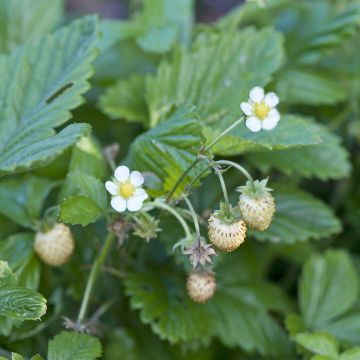
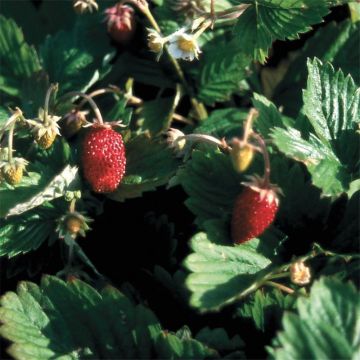
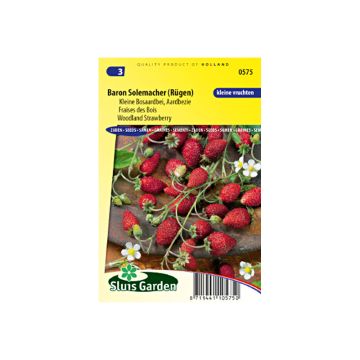
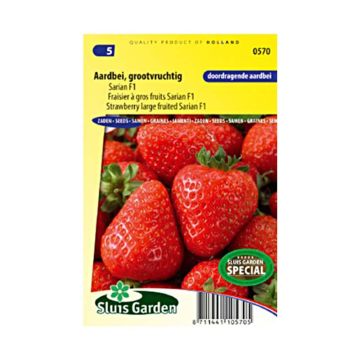
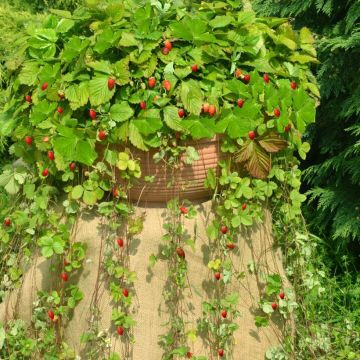
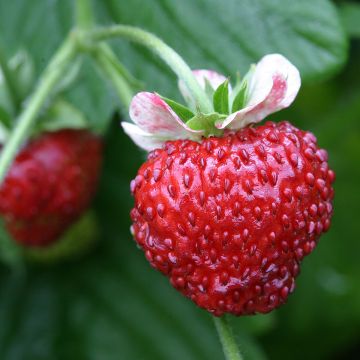
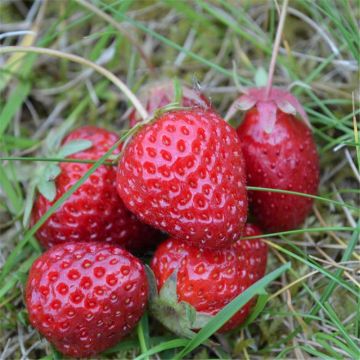
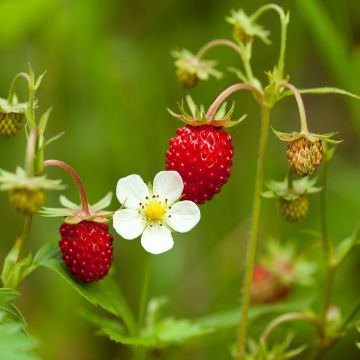
Comments